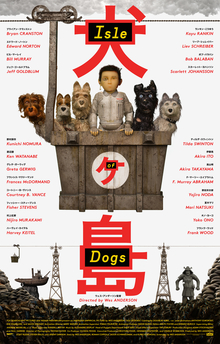REVIEW: Wes Anderson’s Isle of Dogs proves to be unique entry in his film career
April 3, 2018
Wes Anderson has managed for years to capture our attention with his unique style of filming, using extremely centered shots and vibrant colors that illuminate sometimes-sad stories. From the interesting murder-mystery of The Grand Budapest Hotel to the deranged undersea antics of The Life Aquatic With Steve Zissou, and all points in between, Anderson manages to captivate a subtle style of comedy and drama that speaks to many moviegoers.
His newest entry, Isle of Dogs, provides the same sense of wonder as his previous movies, but does so in a style not seen since his 2009 film, The Fantastic Mr. Fox… stop-motion. This movie tells the story of Megasaki City that banishes most pets, all of whom are suffering from terminal illnesses called dog flu and snout fever, to Trash Island, which soon become known as the Isle of Dogs.
Set in the Japanese Archipelago, the film utilizes a common childhood gag, fights being unseen from a giant cloud of dust. One major aspect of the film is that aside from certain characters, all the other characters speak in Japanese. This, however, does not inhibit moviegoers from understanding the storylines presented in this film.
Aside from the dogs being removed from the city, Atari Kobayashi, the young ward of the city’s mayor, hijacks a plane to fly to Trash Island in search of his beloved security dog, Spots. Through this journey, Atari joins with a pack of dogs, all of who had previous owners, with the exception of Chief, a black dog who for most of his life has been a stray.
During their journey to find Spots, Mayor Kobayashi, sends armed guards and new robotic canines to find Atari and bring him back to Brick Mansion, the mayor’s home. In the process of the search, a scientist discovers a cure for the all of the ailments the dogs are suffering from. Kobayashi, however, suppresses the discovery and continues a propaganda campaign against dogs.
Earlier in the film, it is shown that he comes from a long line of people that have hated dogs. Back on the island, Chief and Atari are left alone after the other dogs are separated and accidentally end up going through a trash compactor/incinerator. This leads to a moment where Chief, who was initially hesitant of helping Atari, allows the boy to give him a bath and a doggy treat. It is shown that Chief is actually white once he is cleaned off.
Anderson’s brand of comedy relies on subtlety and wordplay, and not so much on physical insanity and strange sight gags. Intense revelations as shown through the film’s third plotline, become hysterical moments that never miss a beat.
The third plot involves Tracy, foreign exchange student who is a journalist at the city’s high school newspaper. She wants to prove that Mayor Kobayashi has been lying about the existence of a cure for dog flu and snout fever.
Spot finds Atari and Chief, leading to the revelation that Chief and Spots are related, with Chief having been the runt of the litter.
All plotlines come together when during a speech that will end in Mayor Kobayashi killing all of the remaining dogs living on Trash Island. Tracy and a group of pro-dog protestors interrupt Mayor Kobayashi and since he must give them a place to speak their opinions, they are allowed to speak about his true intentions.
After them, Atari comes into the building after bringing all the dogs that helped him back to Megasaki City. He talks about how dogs are important to the city and that they should be allowed to live with them once again. This leads mayor Kobayashi to end the initiative that leads to dogs being forced onto Trash Island.
Afterwards, the dogs, the mayor’s staff, and some of the protestors start a fight that leads with Atari getting seriously injured and Spots is wounded as well. Both are rushed to the hospital and it is discovered that Atari’s kidney has failed; he lost the other in a bullet train accident, which caused him to go live with Mayor Kobayashi.
Mayor Kobayashi, now feeling more charitable, gives one of his kidneys to save Atari’s life. However, this leads to his undoing as Atari is voted into office as the new Mayor of Megasaki City. He uses this newfound power to cure all the dogs infected with dog flu and snout fever.
Unlike many of Anderson’s films, this movie relies heavily on gray tones and great contrast in color. The use of color comes in the form of the characters clothing and certain locations made to match groups of people shown around the city. Some of the colors also come from the buildings, demonstrating the symbolism of power.
One issue of the film is the depiction of Japanese culture. Some people have found that this movie has found is insensitive, though it rally isn’t. At most the film just utilizes some aspects of the culture for the setting, and doesn’t have much basis in reality.
Despite, some of the criticism surrounding the cultural depictions in the film, Anderson delivers a powerful narrative that lives up to his reputation of mysterious yet reassuring films.





